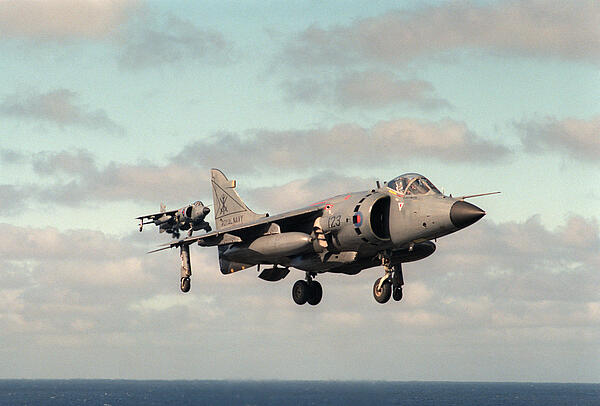The Sea Harrier
Recognised as being a major part of the defences used in the 1982 Falklands War, the Sea Harrier was a vertical take-off plane that was based throughout the conflict on HMS Hermes and HMS Invincible.
The main function of the planes was to act in an air defence capacity - as the Task Force drew close to the Falkland Islands, the domed cockpit of the Sea Harrier allowed pilots to enjoy a far larger field of vision. The vertical/short take-off planes were found to be able to take off with far more power if a small slope was positioned at the bow of one of the ships, allowing the Sea Harrier an additional boost. This was found to be invaluable if the Task Force sensed a threat.
When merged with the sea-to-air missiles stored on board the naval ships, the Sea Harriers helped to create a strong defence against the Argentine Air Force. However, they were not just used in an air defence capacity; rather they were also used to help with ground attacks. While the Sea Harriers were responsible for protecting the vulnerable fleet, RAF Harriers carried out the attack, safe in the knowledge they were supported by the Sea Harriers.

The planes enjoyed an enviable record over the duration of the war – in air-to-air combat scenarios, they achieved 22 victories, losing not a single one in air combat. This record is thanks in part to the heat-seeking AIM-9L Sidewinder air-to-air missiles the Sea Harriers were equipped with. The missiles - which could be used to score a direct, head-on strike on enemy aircraft - boasted an 80 per cent effectiveness record, had a speed of Mac 2.5 and were capable of firing rounds from 2 x 30mm ADEN cannons at a rate of up to 1,700 a minute. Ground fire, however, did claim two Sea Harriers.
When compared to the Argentine Air Force planes, the Sea Harriers allowed the carriers in the Task Force far longer protection – around 30 minutes – before they were forced to land. The Argentine planes needed to land after around five minutes, offering far less protection even when working in shifts.
The Sea Harriers were kept on two of the key ships during the battle, both of which were based some way from the Falklands in order to offer fighters an even higher level of protection. The Argentine military kept Pucaras planes on the Falklands during the battle, which were feared by the Task Force as they had the potential to create much trouble for the ground forces, especially after the landings at San Carlos Bay. However, against the Sea Harriers, these planes offered little defence.
See also: The Wessex Helicopter
MLA Citation/Reference
"The Sea Harrier". HistoryLearning.com. 2024. Web.
